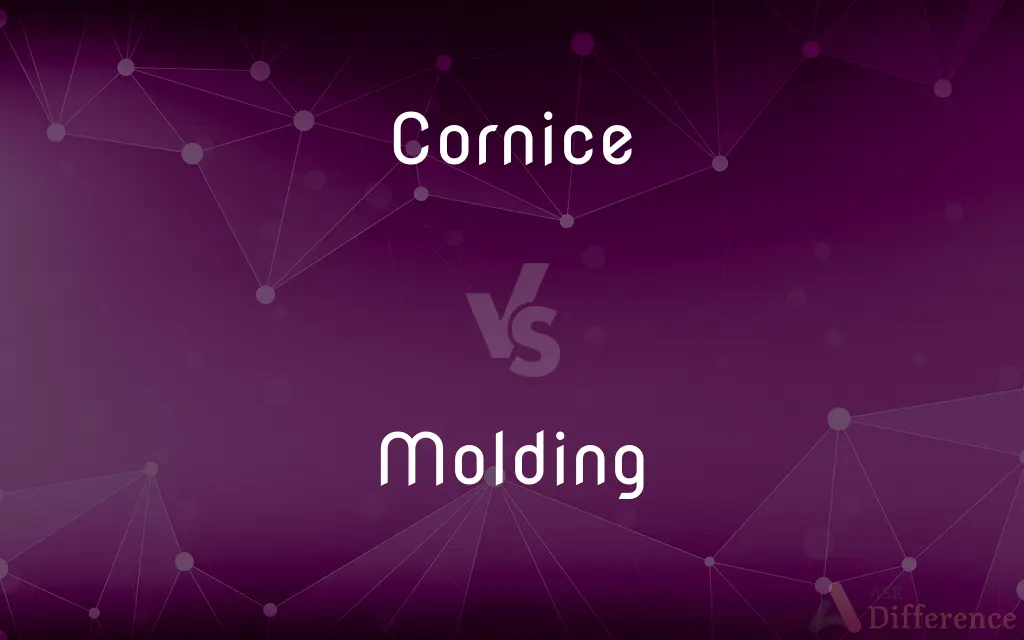Cornice vs. Molding — What's the Difference?
Edited by Tayyaba Rehman — By Maham Liaqat — Updated on April 25, 2024
Cornice is a decorative architectural element that crowns top edge of a building or room, ornately designed, while molding is more general term for embellishments that can be used in various parts of a structure to enhance aesthetics or cover transition.

Difference Between Cornice and Molding
Table of Contents
ADVERTISEMENT
Key Differences
A cornice is specifically used at the top of walls, buildings, or furniture, acting as a cap or crown, often with intricate details. Moldings, on the other hand, can be applied throughout interior and exterior spaces, such as on walls, ceilings, and baseboards, to add character or hide seams.
Cornices are typically associated with the upper sections of an architectural composition, such as the top of windows, doors, or along the roof edges, providing a distinct outline or silhouette. Whereas moldings are versatile in usage, including crown, baseboard, chair rail, and door casing, serving both decorative and functional purposes.
The design of cornices often includes classical elements like dentils, leaves, or scrolls, aiming to project elegance and formality. Moldings, however, may range from simple and sleek to complex and ornate, depending on the architectural style and desired effect.
In historical contexts, cornices were significant in Greek and Roman architecture, symbolizing the uppermost part of the entablature. Moldings, however, have been utilized in a variety of cultures and periods, adaptable to numerous stylistic developments from minimalist to elaborate.
For restoration or replication in heritage buildings, cornices are crucial for maintaining architectural integrity and authenticity. Moldings, while also important, offer more flexibility in matching or creating period-appropriate aesthetics without strict adherence to original designs.
ADVERTISEMENT
Comparison Chart
Location
Top of walls, windows, or structures
Throughout interior and exterior structures
Function
Decorative cap, enhances building silhouette
Covers transitions, adds character
Design Elements
Often ornate with classical motifs
Varies from simple to ornate
Historical Significance
Prominent in classical architecture
Used across various cultures and times
Usage Flexibility
Specific to certain architectural areas
Highly versatile in placement and function
Compare with Definitions
Cornice
An exterior architectural element that crowns a façade.
The building’s façade was defined by a large, stone cornice.
Molding
A strip of material with various profiles used for ornamentation or finishing.
The room’s character was enhanced by elegant crown molding.
Cornice
The uppermost section of moldings along the top of some furniture.
The antique cupboard featured a beautifully carved cornice.
Molding
Can be customized in terms of material and style to match interior designs.
They chose a minimalist molding to match their modern décor.
Cornice
Used metaphorically to refer to something at the top or peak.
His career reached the cornice with his latest project.
Molding
Decorative enhancements within the interior architecture.
The baseboard molding was painted white to contrast with the dark floors.
Cornice
In curtains, a cornice is a box or framework used to conceal curtain rods.
The window treatments were finished with a wooden cornice.
Molding
Functional in concealing wiring or preventing dust collection in crevices.
The intricate molding also hid the surround sound cables.
Cornice
An ornamental molding around the wall of a room just below the ceiling.
The grand hall was crowned with a gold-leafed cornice.
Molding
Used to create a smooth transition between different surfaces.
The molding covered the joint between the wall and ceiling.
Cornice
In architecture, a cornice (from the Italian cornice meaning "ledge") is generally any horizontal decorative moulding that crowns a building or furniture element – the cornice over a door or window, for instance, or the cornice around the top edge of a pedestal or along the top of an interior wall. A simple cornice may be formed just with a crown, as in crown moulding atop an interior wall or above kitchen cabinets or a bookcase.
Molding
The act or process of molding.
Cornice
A horizontal molded projection that crowns or completes a building or wall.
Molding
Something that is molded.
Cornice
The uppermost part of an entablature.
Molding
An embellishment in strip form, made of wood or other structural material, that is used to decorate or finish a surface, such as the wall of a room or building or the surface of a door or piece of furniture. Also called mold1.
Cornice
A strip of molding that runs along the upper part of a wall just below the ceiling.
Molding
Present participle of mold
Cornice
An ornamental horizontal molding or frame used to conceal rods, picture hooks, or other devices.
Molding
The act or process of shaping in or on a mold, or of making molds; the art or occupation of a molder.
Cornice
An overhanging mass of windblown snow on a ridge or the crest of a mountain.
Molding
Anything cast in a mold, or which appears to be so, as grooved or ornamental bars of wood or metal.
Cornice
To supply, decorate, or finish with or as if with a cornice.
Molding
(architecture) A plane, or curved, narrow surface, either sunk or projecting, used for decoration by means of the lights and shades upon its surface and to conceal joints, especially between unlike materials.
Cornice
(architectural element) A horizontal architectural element of a building, projecting forward from the main walls, originally used as a means of directing rainwater away from the building's walls.
Molding
(woodwork) A planing machine for making moldings.
Cornice
A decorative element applied at the topmost part of the wall of a room, as with a crown molding.
Molding
(founding) A machine to assist in making molds for castings.
Cornice
A decorative element at the topmost portion of certain pieces of furniture, as with a highboy.
Molding
(milling) A mill for shaping timber.
Cornice
An overhanging edge of snow on a ridge or the crest of a mountain and along the sides of gullies.
Molding
(founding) A kind of sand containing clay, used in making molds.
Cornice
(transitive) To furnish or decorate with a cornice.
Molding
The act or process of shaping in or on a mold, or of making molds; the art or occupation of a molder.
Cornice
Any horizontal, molded or otherwise decorated projection which crowns or finishes the part to which it is affixed; as, the cornice of an order, pedestal, door, window, or house.
Molding
Anything cast in a mold, or which appears to be so, as grooved or ornamental bars of wood or metal, or sculptures.
Cornice
A decorative framework to conceal curtain fixtures at the top of a window casing
Molding
A decorative strip used for ornamentation or finishing.
Cornice
A molding at the corner between the ceiling and the top of a wall
Molding
A preliminary sculpture in wax or clay from which a finished work can be copied.
Cornice
The topmost projecting part of an entablature
Molding
Used in making a mold or moldings; used in shaping anything according to a pattern.
Cornice
Furnish with a cornice
Molding
The act of creating something by casting it in a mold
Molding
A decorative strip used for ornamentation or finishing
Molding
A decorative recessed or relieved surface on an edge
Molding
Sculpture produced by molding
Molding
A preliminary sculpture in wax or clay from which a finished work can be copied
Common Curiosities
How is molding different from a cornice?
Molding is a general term for trim used anywhere in a building, whereas a cornice is specifically placed at the top of a wall or facade.
What materials are used for moldings?
Moldings can be made from wood, plaster, polyurethane, and even stone or PVC.
Can cornice be used in modern architecture?
Yes, cornices are adapted for modern architecture, often with simpler, cleaner lines.
What is the purpose of a cornice in architecture?
The purpose of a cornice is to add a decorative touch while also helping to throw rainwater off the building.
How do I choose the right cornice for my home?
Consider the overall architectural style of your home and the ceiling height.
Can moldings affect the resale value of a home?
Yes, high-quality moldings can enhance a home's aesthetic appeal and increase its market value.
What is the most common type of molding?
Crown molding is one of the most popular types, used to decorate the space between walls and ceilings.
Is installing a cornice expensive?
The cost can vary widely depending on the material and complexity of the design.
Can I install moldings myself?
Many moldings, especially those made from lightweight materials, can be a DIY project.
Are there different styles of cornices?
Yes, styles range from heavily ornate classical motifs to streamlined modern designs.
Share Your Discovery

Previous Comparison
Parcel vs. Package
Next Comparison
Lithe vs. FlexibleAuthor Spotlight
Written by
Maham LiaqatEdited by
Tayyaba RehmanTayyaba Rehman is a distinguished writer, currently serving as a primary contributor to askdifference.com. As a researcher in semantics and etymology, Tayyaba's passion for the complexity of languages and their distinctions has found a perfect home on the platform. Tayyaba delves into the intricacies of language, distinguishing between commonly confused words and phrases, thereby providing clarity for readers worldwide.














































